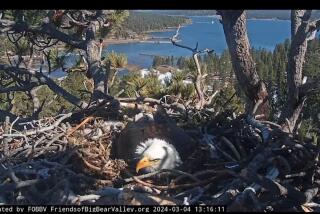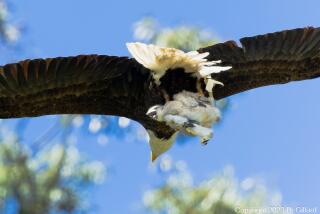‘Eagle Lady’ Invites 350 Eagles for a Daily Breakfast of Fish
- Share via
HOMER, Alaska — Over and over, Jean Keene swings the hook into the plastic trash can filled with aging fish. She tugs out chunk after odorous chunk and flings them over her wooden fence as bald eagles wheel in and snap them up in their talons.
“I just hate to see anything go hungry, no matter what it is,” Keene said.
The bald eagle, America’s national symbol, is an accomplished scavenger that rarely starves in Alaska, but about 350 of them may find life easier since Keene began having them over for breakfast every winter morning.
Keene, a former truck driver and rodeo trick rider who lives in a tiny motor home near the tip of the Homer Spit, a tongue of sand jutting five miles into Kachemak Bay, started the feedings 15 years ago in this small fishing port and artist colony 125 miles south of Anchorage.
At up to two pounds of food per bird per day, the task is demanding for the 71-year-old retiree known as the Eagle Lady.
Clad in rainwear and orange rubber gloves, she maneuvers a stream of visitors into positions close enough for good snapshots, but not too close.
Keene limits her yard to two photographers a day. Her calendar is packed during the late winter months, when morning light is stronger and comes earlier.
“Ain’t no better place I know of,” said photographer D. Robert Frantz of Denver, who recently shot more than 100 rolls of film in Keene’s yard in a week. “You get chance after chance--they just keep banking in.”
Alaska is home to 35,000 to 40,000 bald eagles, compared with about 8,000 scattered about the Lower 48.
Tens of dozens show up for chow at Keene’s home before daybreak, most of them flying in from the thick forests across the bay, as Keene lobs them salmon heads and tails, some cod and herring, and occasionally freezer-burned meat.
The eagles chase off the lurking sea gulls, grab the slabs and head to open ground to eat.
Until last year, Keene worked at a fish-processing plant, which annually supplies her with about 45,000 pounds of discarded fish.
“When she was employed with us, we saw it as an employee-interest thing,” said Icicle manager Charlie Roberts. “It’s just a tradition now.”
For Keene, the end of feeding means three hours of fetching and chopping hundreds of pounds of fish for the next day.
Biologists say that feeding the eagles during times of food scarcity won’t cause them to lose their wild instincts.
“Unlike some mammals, eagles are untamable,” said Mike Jacobson, a bald eagle biologist with the U.S. Fish and Wildlife Service in Juneau. “Eagles are opportunistic--they go after whatever food source they can find.”
More to Read
Sign up for The Wild
We’ll help you find the best places to hike, bike and run, as well as the perfect silent spots for meditation and yoga.
You may occasionally receive promotional content from the Los Angeles Times.






